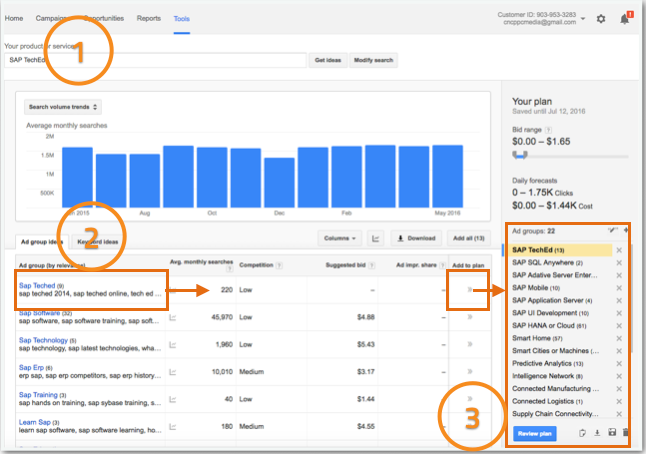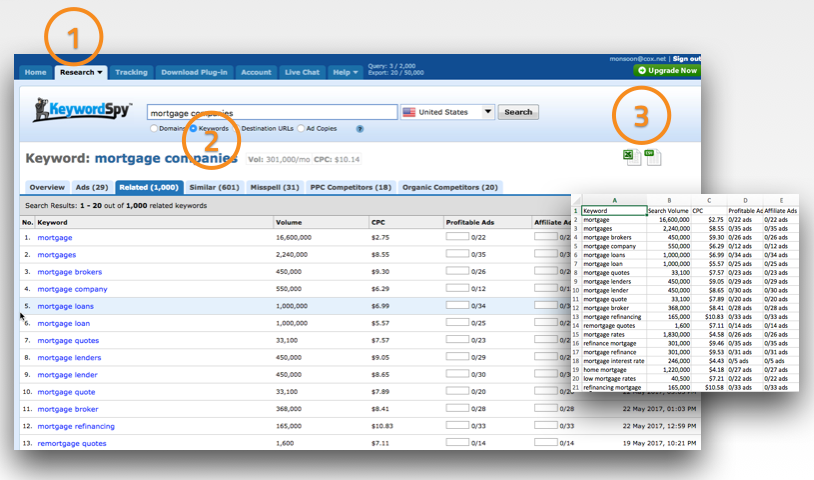Here, we’re going to show you a process for uncovering hidden content opportunities: somewhat less obvious topics of interest to your audiences that don’t fit into the processes linked above. This is important because otherwise, all you have access to are low/medium/high labels rather than the actual average monthly search volume numbers. Once you have access to your account, go to Tools, and select Keyword Planner from the drop-down list. Review the related topics and the search volume for each and select the most desired, relevant topics. Enter a seed topic, get ideas, select relevant candidate phrases, and export the list as a .csv file. Once you have your data—you have keywords, phrases and search volume—you use this worksheet. Just as with your search data, when you paste the numbers into the spreadsheet, they will automatically be given a relative score from one to five. At this point, your worksheet has keywords and phrases, search volume, social volume, and a rating score for both search and social. Either is a proxy for popularity which is a social media measure for search volume. That is the topic archaeology process: Keyword search volume, plus social chatter volume, and a ranking score to deliver a data-driven, prioritized list of topics based on popularity.

This guide was co-written by Jay Baer and Convince & Convert Strategist, Anthony Helmstetter.
To work through this process, download this Excel worksheet.
In previous blog posts, we’ve covered how to identify content assets and gaps, based on the most important persona questions. We’ve covered the 5x5x5 questions and content gap analysis and the roles of “bricks and feathers” and Youtility content. Here, we’re going to show you a process for uncovering hidden content opportunities: somewhat less obvious topics of interest to your audiences that don’t fit into the processes linked above.
We want to prioritize these “hidden” content opportunities based as much as possible on actual data. But where does that come from? Where do we get new ideas for content our audiences will love?
Topic archaeology is a process we have used at Convince & Convert for clients all over the world. We like it because it uses data from organic search and social chatter to identify topics people actually seek and discuss.
What Is Topic Archaeology, and Why Is It So Important?
Topic archaeology uses a data-driven method to unearth, uncover, and identify topics relevant to your potential audiences. The process has four parts: topical seeds, keyword research, social listening, and scoring and ranking.
Start with Topical Seeds
The first part is your topic intuition. Identify 20 relevant topics within your key audience segments that are not well covered by the 5x5x5 questions process. These should be topics that you have not thoroughly covered in your existing content. Put these 20 seed topics in a spreadsheet.
Research Search Popularity
Query your list of topics in a keyword research tool of your choosing. Select relevant suggestions, permutations, and adjacent topics as candidate phrases. You can use Google Keyword Planner which resides within Google Analytics.
Note: To use Google’s Keyword Planner, you must have a Google analytics account, and you must have an active Google paid search campaign set up to access the full details of search volume. This is important because otherwise, all you have access to are low/medium/high labels rather than the actual average monthly search volume numbers. For purposes of this exercise, it is important to have actual monthly search volume. If you do not have a Google Analytics account and a Google paid search account, you can easily set one. To have an active pay-per-click account in Google, you’ll need to provide your credit card for the campaign—however, you do not have to turn the campaign on. Hence, no credit card charges.
Once you have access to your account, go to Tools, and select Keyword Planner from the drop-down list. Insert your first topic, and select Get Ideas. Review the related topics and the search volume for each and select the most desired, relevant topics. Add at least five different, related terms and phrases and select Add to Plan move them into an ad group; if they’re not relevant, don’t add them. Repeat this process with each of your 20 seed topics. When you’re done, export your new list with accompanying data as a .csv file.

As an alternative, you can use KeywordSpy, which offers a free trial and does not require a credit card. If you chose to use KeywordSpy instead, you essentially repeat the same steps described above. Enter a seed topic, get ideas, select relevant candidate phrases, and export the list as a .csv file.

So, if you already have a…

COMMENTS